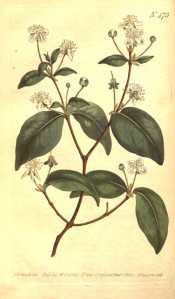Eugenia uniflora L.
Frost-tender shrub or small tree with ovate-lance-shaped leaves, to 10cm, and solitary, fragrant white flowers, usually at the base of young shoots, followed by edible red to black fruits, 3cm across. To 7m. [RHSD, Hortus].
Horticultural & Botanical History
There are many commercial varieties. Probably first cultivated in Britain in 1759 by Phillip Miller. ‘The Plinia pedunculata, in its foliage and flowers, bears a great resemblance to some varieties of the Myrtle, of which genus Linnaeus, following others, at first made it a species; on this account it may be regarded, in a certain degree, as an ornamental plant, it is moreover a very rare one: its flowers yield a considerable fragrance, much like that of the Orange blossom. It is a native of the Brazils, and also of Jamaica, according to Dr. Brown, and others: was cultivated here by Mr. Miller, in 1759. Our drawing was made January 18, 1799, from a plant in the tan stove of the Apothecaries Garden at Chelsea, which has been there a great number of years, and is now become a small tree, covered every year with a profusion of blossoms, which in some seasons have been followed by fruit.’ [BM t.473/1800].
History at Camden Park
Listed only in the 1857 catalogue [T.443/1857]. Several mature specimens grow in the gardens today, probably from the original planting.
Notes
Recorded as a weed in coastal Queensland but not in NSW.
Eugenia uniflora O.Berg (c.1898) = Eugenia lineatifolia Mattos, syn. Eugenia bergii Nied.
Published Jan 17, 2010 - 03:24 PM | Last updated Mar 29, 2010 - 03:43 PM
| Family | Myrtaceae |
|---|---|
| Category | |
| Region of origin | South America |
| Synonyms |
|
| Common Name | Pitanga, Surinam cherry, Brazilian cherry |
| Name in the Camden Park Record |
Eugenia uniflora |
| Confidence level | high |


